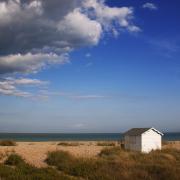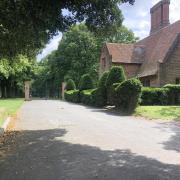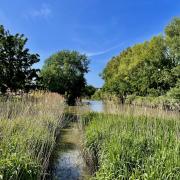Restored and reinvented for the 21st century and beyond, Sheerness Dockyard Church has risen from the ashes to become a beacon of hope.
World-class. That was the reputation of Sheerness Naval Dockyard for more than three centuries before its closure in 1960 – and now the Sheerness Dockyard Church is world-class once again.
After decades of neglect, it has risen from the ashes of a devastating fire in 2001 to become an enterprise centre and cultural hub serving the Isle of Sheppey and beyond.
The landmark Grade II* listed building, with its clock tower dominating the skyline next to the busy port, also serves as a public attraction, with a coffee shop and sections of the important Dockyard Model, which dates from the 19th century, on permanent display.

The rescue, repair and restoration of the building by Sheerness Dockyard Preservation Trust (SDPT), led by architectural conservationist Will Palin (son of Monty Python actor Michael Palin) has also led to the Dockyard Church being taken off Historic England’s Heritage at Risk Register.
This epic £9.5m project, including a £5.3m grant from The National Lottery Heritage Fund, has not only created a vital new economic and cultural asset but it is expected to be the catalyst for further regeneration and investment into the island, which suffers from high unemployment and 40 per cent child poverty.

Will says he doesn’t think there many other examples of a historic building that has been repurposed ‘so imaginatively and so beautifully’.
'Sheerness Dockyard Church is a world-class facility created through a project that was the best anywhere, restoring a building that was beautiful in the first place.
'If this was in London, it would be considered a spectacular space – but on Sheppey it is much more than that – it raises the bar across the whole region in terms of quality of architecture and the imagination that went into the renovation,' says Will.
'The project involved the loving repair and conservation of every inch of the exterior of this building. Cracked brickwork was knitted back together and stonework meticulously repaired by the finest craftsmen. The clocktower itself, unstable following the 2001 fire, had to be dismantled and rebuilt. The majestic new roof, supported by new timber trusses, sits behind a stone balustrade – a faithful reproduction of the original Georgian design.'

When Will first saw the Dockyard Church in 2006 it had no roof or windows, and trees grew where there was once an aisle and pews. While most others would have been put off by the building’s desperate state, he saw only its potential: 'I saw a spectacular monument, built in 1828 by Georgian architect George Ledwell Taylor, in a poor state but ripe and ready to be transformed in some way to remind people of the incredible maritime architecture in the area – Sheerness was once one of the most important places in Britain.
'Since the closure of the Naval Dockyard in 1960, the island’s star had faded, but I knew that once that church was restored it would do something transformative in terms of how people would view the area - not just from the outside, but from the inside, too. This building’s new life would be symbolic of the changing fortunes of Sheerness in terms of its culture, heritage and identity.'
Islands often have a particular character and Will certainly seems to appreciate that of Sheppey: 'There’s a sense of independence and self-sufficiency on the island. The landscape also leaves a strong impression – the flatness, industry contrasting with the little seaside town of Sheerness, as well as one the country’s most important bird sanctuaries and a busy, slightly gritty port.

'There are many beautiful things here that not a lot of people knew about, because Sheerness is not generally on the Kent tourist trail. There is something powerful and curiously magical about a place you had no idea existed and no preconceptions about what to expect.
'There are so many unexpected and interesting things on the island, together with such a strong community. Yes, there are lots of issues but underneath it all is this resilience and pride in the island – so I knew once we started this project, and if we did it well, we could tap into that and derive a lot of energy and support from that.'
And how has he found that people are reacting to the restored building? 'People are now blown away by the contrast between what the building was and what it is now. The Dockyard Church now stands as proof that even our most battered, desperate and seemingly hopeless heritage treasures can be brought back to life if there is a compelling vision – and the energy and ambition to carry the project through. We would like to thank our many funders, led by the Heritage Fund, made possible by National Lottery players, and our design team (Hugh Broughton Architects and Martin Ashley Architects), project managers Glevum Consulting and, of course, our skilled contractor Coniston Ltd and sub- contractors – all who have made vital contributions to this special project.'

IslandWorks [islandworks.co.uk] runs the coffee shop and hire of the co-working space desks and meeting rooms created for people of all ages. Its CEO, Paul Andrews, says the building is ‘a perfect metaphor’ for young business people. 'It's a wonderful place to hang out – it also shows what is possible. The Dockyard Church was in such a sorry state and now so magnificent that the entrepreneurs can look at this building and think "don’t give up, you never know what it possible".'
Working in conjunction with IslandWorks to provide business services for the under 30s is Kent Foundation [kentfoundation.org]. Director Stuart Tanton says entrepreneurs aged 18 to 30 with a business idea or already trading but wanting to grow a business can get in touch to access free business support at the Dockyard Church. 'Anyone with a solid, researched idea can benefit from a business mentor, who gives one-to-one support and advice on a start-up business, or, if moving to a new level of growth, we can help to measure and adapt plans.
'All services are free of charge and, in the first instance, we arrange a meeting at the Dockyard Church to assess the business idea to offer the most relevant support from a Kent Foundation coordinator and an ongoing plan to provide all the available resources to take a business idea forward.
'We'll also be holding workshops and Dragons’ Den-style events, with a young business-owners networking event taking place on October 19' - visit kentfoundation.org/islandworks for details.'

History of Sheerness Dockyard Church
The Dockyard Church was built in 1828 to serve the officers and workers of the new 53-acre Royal Naval Dockyard at Sheerness, which replaced a smaller dockyard where Admiral Lord Nelson had been brought back to Britain in a barrel of rum after his death at the Battle of Trafalgar in 1805.
Architect George Ledwell Taylor, surveyor to the Admiralty, worked to a masterplan by the great engineer John Rennie. Rennie had prepared the Dockyard site by driving in millions of timber piles into the marshy coastal ground and his dry docks and basins and mast house were the envy of the engineering world.
The church continued to be in use for a time after the closure of the Naval Dockyard in 1960 when more than 2,500 skilled workers lost their jobs and started the decline of the once the thriving island.
FIRST IMPRESSIONS
Visitors to the Dockyard Church are unanimous in their praise for the building and its potential to be a catalyst for further regeneration of the area.
The Rt Rev Rose Hudson-Wilkin
Bishop of Dover
An institution was destroyed by the fire but this building now carries a wonderful symbolism of the past and hope for the future.
Tim Gibson
Leader of Swale Borough Council
I was on the scene as a firefighter when the building caught fire in 2001 and I never thought I would see the
day it would be brought back so magnificently.
Freddie Taylor
Oasis Academy student
I was astonished by the size of the building and really like the contrast between old and new.
Leisse Gambell
Commanding Officer of Sheppey Sea Cadets
I was taken aback by the scale of what has been achieved here for the community.

















![The torchlit Wassail procession makes its way to the New Ash Green Community orchard [Photo courtesy of New Ash Green Woodlands Group]](/resources/images/128x89/1x/17558355.jpg)
![The torchlit Wassail procession makes its way to the New Ash Green Community orchard [Photo courtesy of New Ash Green Woodlands Group]](/resources/images/180x180/1x/17558355.jpg)








